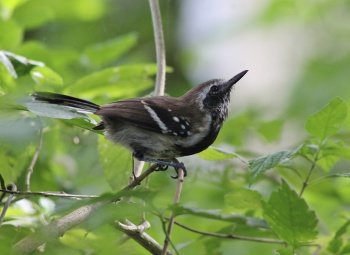- Formicivora grisea
Identification
12–13 cm (4¾-5 in)
- Grey-brown crown and upperparts
- Black wings, tail, lower face and underparts
- 2 white wing bars
- White stripe running from above the eye down the sides of the breast and flanks
- White tipped tail feathers
Female
- Upperparts similar to the male
However, females of the southern populations are orange below and have an orange supercilium
Distribution
South America: found in Colombia, Venezuela, Tobago, Guyana, Suriname, French Guiana and Brazil.
Taxonomy
Sometimes split in Southern White-fringed Antwren (Formicivora grisea) and Northern White-fringed Antwren (Formicivora intermedia)
Subspecies
There are 9 subspecies[1]:
Northern
- F. g. alticincta: Pearl Islands (Bay of Panama)
- F. g. hondae: North-western Colombia
- F. g. fumosa: Northern base of Andes of north-eastern Colombia and western Venezuela
- F. g. intermedia: Northern Colombia, north-western Venezuela, Margarita Island and Chacachacare Island
- F. g. tobagensis: Tobago
- F. g. orenocensis: Southern Venezuela south of River Orinoco (Bolívar and extreme northern Amazonas)
Southern
- F. g. rufiventris: Extreme eastern Colombia and southern Venezuela (western Amazonas)
- F. g. grisea: Guyana, coastal Suriname, French Guiana, northern and eastern Brazil
Habitat
Occurs in the under and mid-storey of lowland secondary woodland, scrubby bushes on white sandy soils and restinga habitat.
Behaviour
Diet
The diet consists of a variety of small insects, spiders and other arthropods gleaned from undergrowth, twigs and foliage.
Breeding
They construct a grassy hammock nest which is placed low in a tree or shrub. The clutch contains 2 creamy white eggs, with purple markings; they are incubated by both adults.
References
- Clements, J. F., T. S. Schulenberg, M. J. Iliff, S. M. Billerman, T. A. Fredericks, J. A. Gerbracht, D. Lepage, B. L. Sullivan, and C. L. Wood. 2021. The eBird/Clements checklist of Birds of the World: v2021. Downloaded from https://www.birds.cornell.edu/clementschecklist/download/
- Handbook of the Birds of the World Alive (retrieved March 2016)
Recommended Citation
- BirdForum Opus contributors. (2024) White-fringed Antwren. In: BirdForum, the forum for wild birds and birding. Retrieved 24 April 2024 from https://www.birdforum.net/opus/White-fringed_Antwren
External Links
Use Formicivora intermedia to
GSearch checked for 2020 platform.







